Winged costumes have long been a captivating element in tribal dance and rituals, serving as a bridge between the earthly and the divine. These elaborate garments do not merely adorn the dancers; they encapsulate rich narratives, cultural beliefs, and the spiritual essence of the tribes that create them. The use of winged costumes symbolizes transcendence and transformation, invoking the presence of ancestral spirits and the connection to the natural world. This article delves into the multifaceted significance of winged costumes in tribal dance, exploring their symbolism, craftsmanship, cultural rituals, and the transformative nature of movement.
The Symbolism of Wings: Elevating Tribal Narratives
Wings in tribal cultures often symbolize ascension, freedom, and the connection to the spiritual realm. They evoke the imagery of birds and other winged creatures, which are seen as messengers between humans and higher powers. In many tribes, the act of dancing with wings embodies a journey—one that takes the dancers beyond the confines of their physical existence and into a space where they can commune with ancestors and spirits. Such symbolism enriches the narrative of the dance, transforming it into a storytelling medium that resonates with the audience on multiple levels.
Beyond mere aesthetics, winged costumes are powerful symbols of identity and heritage. Within a tribal framework, each costume often tells a story of its own, reflecting the history and values of the tribe. For instance, specific colors, materials, and designs may be chosen to represent particular deities or ancestral spirits. This attachment to symbolism fosters a sense of belonging among participants, as they embody their culture and honor their lineage through these expressions. The act of donning winged attire becomes a rite of passage, reaffirming the tribe’s shared identity and commitment to preserving its traditions.
Moreover, the symbolism of wings extends to the representation of transformation. Many rituals involve themes of death and rebirth, and the winged costumes serve as a physical manifestation of this cyclical nature of life. By embodying the form of birds or mythical beings, dancers mimic the transformative journeys that their ancestors traversed, allowing for a collective experience of renewal and spiritual awakening. The wings, therefore, become a narrative device that elevates the stories told through dance, bridging the realms of reality and myth.
Crafting Winged Costumes: Artistry Meets Tradition
The creation of winged costumes is a meticulous process that intertwines artistry with cultural heritage. Master artisans, often working within the tribe, employ traditional techniques passed down through generations to craft these elaborate garments. The selection of materials—feathers, beads, fabrics, and paints—represents not only the aesthetic qualities desired but also the spiritual significance attributed to each item. For example, feathers may be sourced from specific birds that hold sacred meanings, while colors are chosen based on their representation of different emotions or deities.
Each winged costume is a labor of love, reflecting the unique artistic expression of the tribe while adhering to its cultural narratives. The intricate designs may incorporate symbols and motifs that tell stories or convey teachings important to the tribe’s identity. These costumes are often made collaboratively, with community members contributing their skills and insights, thus fostering a sense of unity and shared purpose. The final product stands as a testament to the tribe’s resilience and creativity, celebrating both individual craftsmanship and collective heritage.
Moreover, the process of crafting these costumes often involves rituals of its own, imbuing the work with spiritual significance. As artisans create, they may sing songs, tell stories, or invoke blessings from the ancestors to guide their hands. This sacred approach transforms the act of costume-making into a spiritual practice, ensuring that each piece is not merely an object but a vessel of cultural identity. The careful attention to detail and the integration of traditional practices ensure that the winged costumes remain a vital part of tribal heritage, continually evolving while honoring their roots.
Dance of the Ancestors: Connecting Through Winged Rituals
In tribal societies, dance is often more than entertainment; it is a profound expression of cultural values and a means of connecting with the spiritual world. Winged rituals frequently serve as a conduit for communicating with ancestors, inviting them to witness and participate in the celebration of life and community. Dancers adorned in winged attire embody the spirits of their forebears, channeling their strength and wisdom through movement. This connection fosters a sacred space where the boundaries between this world and the next blur, allowing for an enriching experience of communion.
During these rituals, the dancers’ movements are deliberate and infused with intention, reflecting the stories and teachings of their lineage. The choreography often mimics the graceful flight of birds, embodying the essence of freedom and spiritual ascension. Each gesture and step is steeped in meaning, from the sweeping arcs of the wings to the rhythmic beats of the accompanying music. This powerful combination of movement and sound creates an atmosphere that captivates both participants and spectators, facilitating a shared experience of cultural remembrance and celebration.
Furthermore, the act of dancing in winged costumes reinforces a sense of communal identity and belonging. As tribes come together for these rituals, they reaffirm their shared history and values, cultivating a sense of collective memory that transcends generations. The dance not only honors the ancestors but also strengthens contemporary bonds within the community, reminding all present of their interconnectedness. In this way, winged rituals serve as a living testament to the enduring legacy of tribal culture, ensuring that the past is woven into the fabric of the present.
The Transformative Power of Winged Movement in Culture
The transformative power of winged movement extends beyond the confines of tribal rituals; it resonates deeply within the cultural psyche. As dancers embody the spirit of flight, they evoke a sense of liberation, inspiring both themselves and their audiences. The physical act of moving through space with wings allows for a release of energy that can lead to personal and communal transformation. Participants often describe a sense of transcendence, where their ordinary selves merge with the divine, enhancing their understanding of identity and purpose within their cultural context.
This transformative experience is not exclusive to the dancers alone but permeates the entire community. Observers are drawn into the narrative, feeling the emotional undertones of the performance as they witness the celebration of life, death, and renewal. The visual splendor of winged costumes, combined with the powerful storytelling embedded within the dance, invites spectators to reflect on their own journeys and connections to their heritage. This immersive experience can inspire cultural pride and a renewed commitment to preserving traditions, fostering a deeper appreciation for the richness of tribal narratives.
Moreover, the impact of winged movement can transcend geographical and cultural boundaries, inviting dialogue about the universal themes of transformation and connectedness. As world cultures increasingly intersect, the symbolism of wings continues to inspire artistic expression across various mediums. Contemporary interpretations of tribal dances featuring winged elements can be found in theater, film, and dance performances worldwide, showcasing the enduring relevance of these traditions. In this way, winged costumes and their associated rituals not only preserve the past but also propel cultural narratives into the future, ensuring they remain vibrant and influential for generations to come.
In summary, winged costumes in tribal dance and rituals are powerful symbols that transcend mere decoration; they embody the rich narratives and spiritual beliefs of the cultures they represent. Through intricate craftsmanship, these garments become vessels of identity, connecting dancers to their ancestors and their communities. The transformative power of winged movement fosters an experience of transcendence and renewal, weaving together the past, present, and future. As we explore these dynamic expressions of culture, we are reminded of the importance of honoring our traditions while embracing evolution, ensuring that the stories of those who came before continue to take flight in our collective consciousness.










